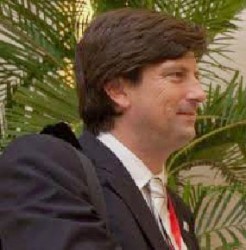Monica Araya is founder and Executive Director of Nivela and leads the citizens group Costa Rica Limpia.
Hans Verolme is founder and Senior Strategic Adviser at Climate Advisers Network.
This article was received from Project Syndicate, an international not-for-profit association of newspapers dedicated to hosting a global debate on the key issues shaping our world.
By Monica Araya and Hans Verolme
BERLIN – The People’s Climate March on September 21 was a watershed for the emerging global climate movement, with more than 400,000 people taking to the streets of New York City. But New York was only the tip of an iceberg. People in 166 countries, from Argentina to Australia, participated in more than 2,800 events and rallies. Two million activists demanded through an online petition that governments shift to 100% clean energy. For the first time since the fated 2009 Copenhagen Climate Change Conference, virtual climate activism moved into the real world. Why?
 Citizens worry about the impact of climate change, and they know that fossil fuels are the problem. They have come to recognize that powerful interests are blocking the necessary shift to clean energy, and they simply no longer trust that their governments are doing enough to stand up for the future of the planet. This was reflected not only in the record number of people who participated, but also in the diversity of the marchers – urban activists, indigenous groups, adherents of different faiths and political viewpoints, and, most conspicuously, old and young.
Citizens worry about the impact of climate change, and they know that fossil fuels are the problem. They have come to recognize that powerful interests are blocking the necessary shift to clean energy, and they simply no longer trust that their governments are doing enough to stand up for the future of the planet. This was reflected not only in the record number of people who participated, but also in the diversity of the marchers – urban activists, indigenous groups, adherents of different faiths and political viewpoints, and, most conspicuously, old and young.
People today draw natural connections between climate change and daily life. Teachers stood for schools that run on renewable energy, women supported healthier agriculture, grandmothers demanded clean air for their grandchildren, unions want a green job transition, and city mayors want investments in energy-efficient buildings.
Five years after the Copenhagen conference failed, governments finally need to act responsibly. This week’s climate summit, hosted by United Nations Secretary-General Ban Ki-moon, was aimed at increasing the momentum for action by gathering government, business, and civil-society leaders. The aim was to create favorable conditions for governments to negotiate a climate deal in Paris in 2015. And, though the UN cannot enforce the promises that leaders made, the summit catalyzed a popular demonstration that has moved the political spotlight back to the climate-change challenge, where it is likely to remain until governments take credible action.
What has changed since 2009 is the degree of concern about the impact of climate change. In the interim, New Yorkers faced Hurricane Sandy, while Typhoon Haiyan devastated the Philippines. Climate records continue to be broken worldwide. In 2014 alone, ordinary people suffered from heat waves in Australia, floods in Pakistan, and droughts in Central America, while the collapse of the West Antarctic ice sheet has been shown to be irreversible.
As a result, the global debate has shifted from the costs of action to the costs of inaction. And, though the costs of climate damage are staggering, scientific research indicates that mitigation costs are manageable.
That has become apparent in the growth of renewable energy generation. People want clean energy, the technologies are available and profitable, and, with millions of people lacking access to reliable power, the emergence of renewable sources is a lifesaver. Global wind and solar energy capacity has tripled since 2009, and renewable energy now provides more than one-fifth of the world’s electricity supply.
Indeed, every second megawatt of new electricity that is added globally is green, implying that the share of renewable energy could reach 50% in 2030. Clean energy is a game changer, because it puts power over power back into the hands of citizens, posing a direct challenge to the fossil-fuel industry. The obvious next step in the fight against climate change is to phase out all subsidies for that industry.
 This week’s UN climate summit may not affect the course of negotiations for an international climate agreement. But it has put the focus back where it should be: real people demanding real change from their governments. Citizens have shown that they are committed and will speak up. The People’s Climate March was only the beginning.
This week’s UN climate summit may not affect the course of negotiations for an international climate agreement. But it has put the focus back where it should be: real people demanding real change from their governments. Citizens have shown that they are committed and will speak up. The People’s Climate March was only the beginning.

